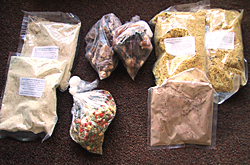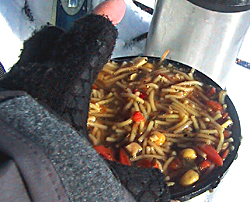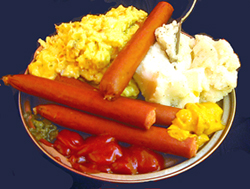Food & Drinks
Variation is of essence when it comes to food, alternate between at least 7 dinners and sample them before expedition. If you don't like it at home, you won't like it on the ice.

Bring treats for important milestones and anniversaries; include salami, beef jerky and equivalent for protein. Beef jerky makes a great barbecue – grill over the burner for a few seconds until curly. Extra Parmesan cheese to top of your pasta dishes is a great fat- and calcium supplement. Spices really add to taste and are powerful antioxidants. Supplement plenty of salt to all food including your trail mix as you will sweat immensely.
Breakfast should be a hot cereal and much of it; it will keep you to lunch. Some cereals like the one from B-well require only warm water to be added.
If you bring enough Thermoses you can boil all water in the evening before and have your morning coffee and breakfast without even lighting up the burner. This saves energy and fuel. Boil up tomorrow's drinking water at the same time, tap on Nalgene bottles and store hot in your sleeping bag overnight. Hot soup for lunch break is easily made of angel hair pasta, a cube of stock and dried veggies. Only a handful of ingredients will swell into a thick, hearty soup. Heat oil, stir in all ingredients for a few seconds, pour hot water over and let stand in a Thermos over night. Fruit soups, hot chocolate and hot juice are other lunch favorites. Img: Nudel and veggie soup for lunch

A good Thermos is of essence for soup and hot drinks, as not all thermoses preserve heat equally well. Nissan stainless steel thermoses are durable and tight. If a Thermos is dented, it will lose isolation power. Check your Thermos by filling it up with hot liquid and toss it into the refrigerator. Check the temperature of the liquid next day. In extreme cold conditions, you should store the thermoses inside the inner tent, wrapped in something isolating (down booties or jacket).
Your trail mix should consist of dried fruit, chocolate and a variety of nuts. Make your own mix and add salt. Again, variation does the trick. Nuts such as almonds, macadamias, walnuts, soy nuts and other all contain good fat and each different nutrients, not only the vitamin E. Dried fruit is an excellent multivitamin, digestion aid and quick energy fix. Chocolate again contains important antioxidants plus it is another calorie packer. Dark chocolate have the best calorie ratio but bring it only if you like it. Break up chocolate in bite size pieces before departure as chocolate freeze solid in severe cold. Pre-pack daily servings of your trail mix in lightweight plastic bags. Count on around 180-250 grams per person per day.
Check calorie/fat ratio of the food you bring, you need high energy versus low weight. Some explorers add uncooked oil to dinners to bring up the energy ratio, but the back draw is diarrhea. Use generous amounts of oil in your cooking, but don't overdo it.
Img: Luxury food for rest day! Everybody have their own favorite camp food. We liked the freeze dried from BeWell. Our favorites were the Bolognese, Milanesa and Lamb Curry. Paul Landry sell some great stuff too, try his Turkey Alfredo! Outdoor store freeze dry favorites were Sweet and Sour Pork, Pasta with Meatsauce and Beef Stroganoff. Sjur Mordre sells an excellent Cod in Cream Sauce.

Notice the variation between seasonings (curry/sweet&sour/cream sauce/tomato sauce/brown sauce) the variation between proteins (beef/mushroom/pork/lamb/fish) and the variety of starches (pasta/rice/potatoes).
The important advice when it comes to food is to bring enough of it. The second most important advice is variation and nutrition value. If you keep a well balanced diet of good fat, protein, fiber and vitamins, you won't even experience food cravings.
Store oil in tight canisters but remember that some oils (olive) freeze solid in cold whilst other (avocado) doesn't. Try it out in your freezer. Nalgene bottles do the trick for solid oil storage if cut in half when oil is hard to get to. Butter is a nice addition but spoils more easily than oil.
Divide all food and snacks in portions prior to the expedition. Each day should contain breakfast and dinner, plus a daily ration of lunch ingredients and the trail mix. Pack the daily ration in a sturdy plastic shopping bag and mark with the dinner menu. Pack seven of the daily rations in a weekly pack. Store the entire weekly content in lightweight sturdy packs and assign each bag to a particular week, signing the bag with a number for each week and the weekly menus. This will really help to keep a fast track of your supply. For a 70 day expedition, you'll end up with 10 bags. Img: 9 day food bags(Ortlieb).
Extras such as drinks, treats, spices and such should be stored in a single, separate bag. Oils, butter and meat in yet another bag, for easy storage outside the tent to avoid spoilage and bedroom bear visitors.